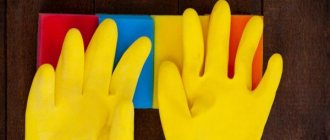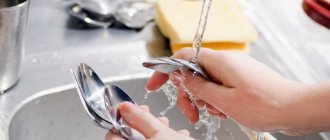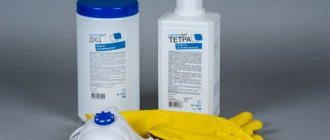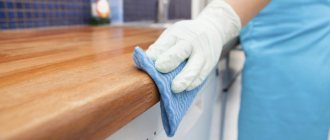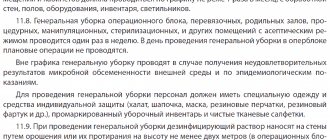01 September 2020
Organizing strict order in the office space, where all conditions have been created for the thoughtful storage of cleaning equipment, disinfectants, detergents, vacuum cleaners, etc., is an excellent basis for professional work. Proper inventory storage allows you to:
- extend its service life;
- make the task easier for the cleaner;
- avoid accidents;
- prevent the spread of infectious diseases;
- organize the most efficient and effective cleaning.
In many organizations, the rules for storing cleaning equipment are determined at the legislative level.
Why do you need labeling of cleaning equipment?
Labeling cleaning equipment according to SanPiN, a sample of which is given in this article, is necessary to prevent cross-contamination of pathogens during cleaning of different areas of the same institution. The marking of equipment for cleaning premises is regulated by a set of Sanitary Rules and Standards.
From January 1, 2022, the Decree of the Chief State Sanitary Doctor of the Russian Federation dated May 18, 2010 No. 58 (as amended on June 10, 2016) “On approval of SanPiN 2.1.3.2630-10” became invalid.
And a new decree of the Chief State Sanitary Doctor of the Russian Federation dated December 24, 2020 No. 44 “On approval of sanitary rules SP 2.1.3678-20 “Sanitary and epidemiological requirements for the operation of premises, buildings, structures, equipment and transport, as well as the conditions of business activities” came into force entities engaged in the sale of goods, performance of work or provision of services" (Registered with the Ministry of Justice of Russia on December 30, 2020 No. 61953).
Marking of cleaning equipment at catering establishments
It is not regulated by a clear purpose of colors. Therefore, each enterprise can independently designate its own colors for each zone. For example, red is for cleaning a meat shop, blue is for a fish shop, green is for a vegetable shop, yellow is for a flour shop. Employees often wonder what color equipment is used to clean the distribution area ? – you can use green color, it can also be used for cleaning equipment of bar counters and tables where food is consumed.
Another frequently asked question: is specially marked cleaning equipment required for refrigerated rooms ? – the answer is definitely “Yes!”, for cleaning each group of premises (hot and cold shops, meat and fish shops, flour and confectionery shops, semi-finished products preparation shops, procurement shops, non-refrigerated warehouses, refrigerated chambers, auxiliary premises, sanitary facilities ) allocate separate marked cleaning equipment, in accordance with the requirements of SanPiN 2.3.2.1324-03 “Hygienic requirements for shelf life and storage conditions of food products.”
Documentation
- Store documents by dividing them into just two categories: those that need to be kept and those that need to be dealt with. The last category includes letters that require a response, questionnaire documents, etc. It is better to store these papers in a separate vertical organizer. At the same time, you need to try to keep it... empty. Its fullness will mean that your affairs are not being solved very productively. The first category of documents is most conveniently divided into rarely used (warranty cards, policies, etc.) and frequently used (for example, current educational materials).
- Organizers with too many compartments make it difficult to sort and find the documents you need. For example, you shouldn't use accordion folders.
Color coding of cleaning equipment
Very often, workers in various fields are faced with the question of what color rags and cleaning equipment for cleaning bathrooms are coded according to the international cleaning marking system ; the answer to this question is given in the table below.
| Equipment that is used in rooms with a high degree of bacterial contamination (toilets, bathrooms, storage rooms for dirty linen) is marked red. |
| Green color is used to mark equipment that is subject to more stringent cleanliness requirements (operating room, areas for storing, preparing and consuming food, kitchen, bar counter). |
| Blue or cyan color is applied to equipment and inventory used for places with slight contamination (corridor, reception areas, shop windows, lobby, office, hospital ward, resident's room, hotel room, classrooms in schools and preschool institutions). |
| Yellow color is used to mark equipment used for cleaning conditionally dirty premises (gyms, warehouses and utility rooms). |
| Cleaning equipment marked white can be used for cleaning other rooms. |
Go to the cleaning equipment catalog
Equipment storage room: requirements for ventilation and fire and explosion safety
An inventory storage room is installed in any industrial or residential premises for personal or business use.
This category of premises is designed to store gardening equipment, cleaning tools and other items in a storage room, the area of which varies from a couple of square meters to huge warehouses.
Loading …
Rules for storing cleaning equipment
Cleaning equipment is not only stored in the pantry, but also cleaned and dried.
This imposes a number of mandatory requirements for the arrangement - cold and hot water supply, an adjacent restroom, and its area is not regulated.
Cleaning a building or room can be simple wet or more complex using a vacuum cleaner and other types of equipment.
Requirements for a cleaning equipment storage room
Despite the simplicity of the premises, the Cleaning Equipment Storeroom has strict requirements, but depending on the footage, they are changeable. In particular, on a floor of 100 square meters, the toilet storage area should be at least 0.8 square meters.
A floor area of about 400 m2 requires a storage room on two floors at once. The closet turns out to be an adjacent type, and the need for explosion and fire safety and good ventilation becomes mandatory. In this case, specialists calculate the frequency of air exchange.
There are also a number of requirements for finishing work:
- moisture resistance. Finishing is carried out with water-repellent materials in a layer of 2.1 meters. The best option would be ceramic tiles coated with a layer of oil paint;
- waterproofing the floor covering. The layer of waterproofing materials should be at least 30 cm, and the edges must rise to the wall. This type of insulation work can be found in bathrooms;
- fire protection door. This requirement is especially important in rooms with an area of 11 square meters or more - the door requires fire safety category B;
- presence of a sewer pipe. This could be a drain, a sump, or a toilet going into the sewer. During cleaning, dirty water is poured into these drains. Drains are considered the least convenient method, so they are often replaced with pallets or toilet bases. It is allowed to use shower trays with a size of 0.9 * 0.9 meters or 0.8 * 0.8 meters;
- equipment for industrial cleaning in the building. For mechanical cleaning, you will need to install several vacuum cleaners, which are more convenient to bring in through sliding doors;
- a sign on the door stating the purpose of the room and the prohibition on the presence of outsiders. A fire door will prevent open fire from spreading throughout the building, even if there is a fire or explosion inside. The cleaning equipment storeroom always contains a number of explosive and caustic chemical solutions and substances, the improper storage of which can harm the health and life of people;
- fire-resistant entrance block if the pantry is located in an elevator shaft or fire barrier. Only a professional team that has a special license to carry out this type of activity can install a structure that is resistant to open flames indoors.
Cleaning equipment storage room
How to choose the right door to the inventory storage room?
Whatever the area of the storage room for gardening or cleaning equipment, the door should be made of steel.
As a rule, a single-leaf model with different levels of fire resistance is installed. The external finish can be powder coated or GF-021 enamel-primer.
This door contains three reliable components:
- filler basalt slab, non-flammable type;
- seal against the penetration of cold smoke and hot steam;
- thermally active strip for maximum door tightness.
How to store equipment at the dacha?
At the dacha, a storage room for cleaning equipment is also made, but tools, gardening equipment, equipment, and seasonal items are stored inside.
In this case, the pantry is made so that it does not take up much space on the site without losing useful space inside.
It is necessary to arrange a storage room for garden tools in the country carefully so as not to clutter the room.
It is not recommended to store broken things or rusty equipment, old cans of paint, varnishes and other unnecessary things. Free space inside the country storage room will help you better navigate it and perform some work.
We recommend to buy
Arrangement of the working area of the country pantry
At the dacha, furniture is often repaired, indoor flowers are replanted, and tools and garden equipment are also repaired. To do this, you need a work surface with a stable base.
It is recommended to place several drawers or shelves under the tabletop for things that should be at hand while working. Wooden boxes are attached to the walls near the table. You can place containers or containers with small items, crayons, pencils, scissors, accessories, etc. on them.
Suspension systems
Garden equipment and tools are best stored hanging. Hanging shelves around the entire perimeter will free up additional space on the floor.
Containers and cabinets are hung near the ceiling, in which you can fit a lot of necessary and non-format things.
Marking of cleaning equipment (sample)
InventoryPurposeMarkingMarking methodBucket For cleaning toilets UB Oil paint on the outer surface of the bucket Brush, mop For washing floors For floors Marking is applied with oil paint on the handle of the brush or mop handle, if the handle or handle is made of wood, then the burning method is used Burlap For washing bathrooms A red flap A red flap is sewn onto the corner of the burlap Napkins For washing the walls of corridors With green napkin colorsCleaning cloths are used in different colors for each zone. Mops for cleaning floors in a hotel room. Mops are blue or the colored tags are cut off and only the blue label remains. Mops for cleaning can be either in different colors (corresponding to each cleaning zone), or with sewn-on colored labels in four different colors, three of which are cut off and one label of a certain color remainsCloth
- It is optimal to carry out a wardrobe audit in the following order:
- Tops (shirts, sweaters, etc.);
- Bottoms (skirts, trousers, etc.);
- Clothes that need to be hung on hangers;
- Socks;
- Underwear;
- Bags;
- Accessories (belts, hats, scarves, etc.);
- Special clothing (swimsuits, sportswear, etc.);
- Shoes.
- It is better to fold/hang things of the same category according to the principle from heavy-dark-long to lighter and lighter. For example, things can be sorted by materials such as “wool” and “cotton”. In the drawers, light and light things should be in the front so that your wardrobe makes you happy.
- Use the bag-in-bag method (no more than 1-2 bags in one bag). At the same time, the bag straps should be visible from the outer bag so that you do not forget about them. It is also desirable that the outer and inner bags are similar in material, season and/or style. Thanks to this trick, you will save space and maintain the shape of your accessories.
- Even fold socks and tights into rectangles. Place them all together in a box or drawer in an upright position so you can see each pair. As Marie says, “Treat your socks with respect.”
- Cup bras should be placed carefully next to each other to ensure they maintain their shape. Soft bras should be folded in half and then folded over the straps. Store your bras in a nice basket, like rattan. After all, everything that comes into contact with the body must be kept with special respect.
- If you have a shoe rack, place heavier shoes on the bottom and lighter shoes on top. Then arrange the pairs by color to keep everything organized.
Marking of mops according to SanPiN
Should be applied to the handle or handle of the mop. You can, of course, mark with oil paint or a marker, but this is an unreliable and outdated method, since the paint and marker quickly rub off from the surface. Today, handles from ]TTS[/anchor] (TTS) are developed taking into account the requirements of SanPiN and are marked with a cap of a certain color at the end of the handle. Another advantage of such handles is their ergonomics - they are telescopic and adapt to the operator’s height.
Books
- If there are too many books, they can be sorted into subcategories in the following order:
- Fiction;
- Applied books;
- Illustrated, for example, art albums;
- Magazines.
- When sorting out books, do not start reading them, as this almost always delays cleaning.
- By and large, only those books that belong in your “hall of fame” will remain in your home. For example, Marie herself keeps only 30 books in her house, although she previously had a large library.
- According to Kondo, unread books will never be read. They also tend to accumulate. Therefore, you need to get rid of them.
Cleaning equipment for medical institutions
Carts, mops, containers, rags, mops must be clearly marked or color-coded taking into account the functional purpose of the premises and types of cleaning work and must be stored in a designated area. The rags are marked as follows: rags for cleaning in staff rooms and wards are marked in blue; red - for cleaning bathrooms; green – dressing rooms, treatment rooms; yellow – utility rooms.
A color coding scheme for cleaning equipment in medical institutions should be located in the equipment storage area.
Toilet cleaning equipment must be color coded to indicate special attention. Cleaning equipment for the toilet: rags, buckets, brushes are labeled and stored separately from other cleaning equipment.
Equipment for cleaning toilets must be clearly marked in red, which is used in areas with a high degree of bacterial contamination. In the specialized literature there is often a definition that cleaning equipment for cleaning bathrooms must have a signal marking .
Should cleaning equipment for production, utility and auxiliary premises be marked with paint ? – the answer to this question is definitely “Yes!” Also, such cleaning equipment should be stored in separate rooms equipped with special washing baths ( washing equipment ) and drainage devices with hot and cold water supply, as well as a register for drying cleaning equipment.
Detergent storage
It is no secret that when working with professional detergents, extreme caution must be observed. But they also need to be stored correctly, indoors:
- ventilated and locked;
- with dry surfaces and floors;
- maintaining constant room temperature;
- without exposure to sunlight;
- away from the radiator.
Of course, all containers are subject to mandatory labeling. Detergents and disinfectants must have labels that indicate their names, purposes, rules of use, composition, concentration, and expiration date. It is important that the containers are tightly closed with lids.
Satellite products are excellent for cleaning of varying degrees of complexity. All products comply with Rospotrebnadzor standards and have been certified.
List of cleaning equipment subject to mandatory marking:
- Buckets
- Buckets on wheels
- Floor rags (rags)
- Mops
- Mops
- Handles
- Brushes
- Broom
- Scoop
- Squeegees for windows and floors
- Scrapers
- Cleaning trolley
- Bucketless cleaning trolley
- Microfiber cloths
- Trash cans
- Cleaners
- Garbage containers
To summarize, color coding helps:
– avoid cross-contamination and contamination with microbes and bacteria. The reputation of each establishment in the HoReCa sector is very expensive, therefore, in the fight for your client, you must take all possible precautions. And the healthcare, public nutrition and education systems need this vitally.
– marking of cleaning equipment allows you to determine which contamination zone the equipment belongs to, which makes it much easier for management to monitor compliance with cleanliness standards.
Where to hide a vacuum cleaner in an apartment?
We tell you where to store the vacuum cleaner in the apartment so that it is comfortable to use. ...
- Put it in the pantry...
- Place it in the closet...
- Use holders and retractable structures...
- Find a place in the laundry room...
- Place in a niche...
- Find a place on the loggia...
- Put away the dressing room...
- Equip the space under the stairs
29 Dec
2022 Interesting materials:
How many hours can you work on maternity leave? How many hours do we work in October? How many hours does an accountant work? How many hours does a speech therapist work in a kindergarten? How many hours does a speech therapist work at school? How many hours does a speech therapist work? How many hours does a social teacher work? How many hours does the senior teacher work? How many hours does a flight attendant work? How many hours does a teacher work?
